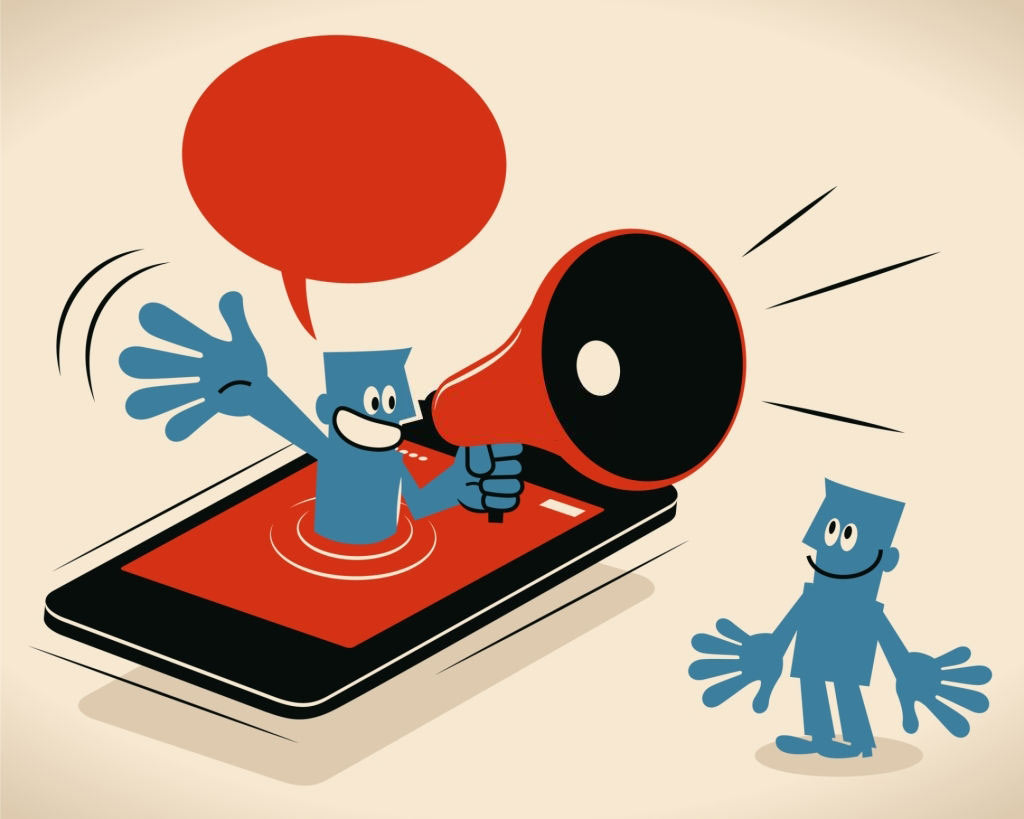As of July 2021, there were 4.48 billion social media users worldwide. This means that nearly 57% of the global population uses social media. Clearly, social media has become a big part of people’s lives in recent times. Social media platforms are not just a means of staying in touch with friends, family, and colleagues; they have also become powerful digital marketing tools for creating brand awareness and customer engagement.
People now use various platforms like Facebook, Twitter, and Instagram to share their experiences. As consumers, they share product reviews, information about services, advice about certain products, and even warnings about certain products. 43% of online shoppers research products through social networks before making a purchase. 75% of people shop online at least once a month.
Social media content has the ability to influence people in specific ways, especially their buying behavior. 76% of US consumers bought a product they saw on a brand’s social media post. 39% of consumers trust brands only after they have interacted with them on some social media platform. 71% of customers are likely to buy a product based on social media referrals.
Without a doubt, social media does have a profound influence on consumer behavior. But how does it do so? A social media questionnaire is an excellent method that can help you gather and interpret online consumer behaviors.
What is consumer behavior?
Consumer behavior refers to how individuals select and use products and services. It focuses on how people choose between different brands and how they research and shop. Three factors influence consumer behavior – personal, psychological, and social.
Personal factors are about the opinions and interests of an individual, which may be influenced by their demographics. Perceptions and attitudes make up the psychological factors. It includes how a person comprehends information and how they see their needs. Social media factors could include social media influence, peer groups, and socioeconomic classes.
Stages in the buying process
Everyone may have their own considerations when making a purchase. However, everyone goes through the “buying process,” and this is a constant process.
The “buying process” can be divided into six stages:
- Need recognitionThis is the first stage of the process where consumers realize that they need something. Buying a product or service is supposed to address that need. A consumer could look at a worn-out shirt and decide that they need to buy a new one. Or, they may be looking at a movie trailer and decide to buy a ticket to see the movie.Businesses should use this as an opportunity to make consumers realize that they have a need or reevaluate an existing one.
- Search for product information Once a customer recognizes their need, they start looking for information on the product that they want to buy. This is the time that they start looking up the internet and social media platforms for product reviews and blog posts. For businesses, websites, search ads, blogs, and testimonials could come in handy at this stage.Brands should consider enhancing brand awareness through SEO and online paid marketing as it also helps build trust and credibility. When consumers trust your brand, it biomes easier to convert prospects into paying customers. Facebook is an excellent platform for highly targeted ads. However, if you are not too familiar with paid ads on this platform, you could seek help from an agency specializing in Facebook marketing for e-commerce Miami.
- Product evaluationThere are several products available in the market that could address the needs of a customer. For instance, if the customer needs a shirt, there are hundreds of clothing brands available in the market. So, how does a customer narrow down the choices? Usually, they consider their needs and create certain criteria. Say, a person looking for a shirt may want a pure cotton shirt for under $100.During this stage, your marketing strategy should be able to convince prospects that you have exactly what they need. If your product’s strengths match their criteria, consumers are more likely to buy your products and not of your competitor’s.
- Purchase decisionIn this stage, a consumer has already looked at multiple items that match their criteria. For instance, if they are looking for a cotton shirt, they must have already looked at many brands that sell cotton shirts. Now, the consumer has to make the critical decision of whether they should purchase the shirt or not. At this stage, businesses should remind the consumers of their needs and focus on creating a sense of security.
- PurchaseAt this stage, the consumer has made up his mind to buy the product. That does not mean that a sure-shot sale is about to happen. There are many factors that could prevent a customer from making a purchase at the last stage. Difficulty in navigating the e-commerce website or a complicated checkout process could cause a brand to lose a sale.
- Post-purchase evaluationThe buying process does not end with a sale. Using and evaluating the product after purchase would dictate if a consumer is satisfied with the product or not. Thank you emails and post-purchase surveys could help brands figure out if customers are facing any issues with the products. These can also address dissatisfaction while also cultivating a positive relationship with customers.

How does social media marketing influence consumer behavior?
By studying consumer behavior organizations can create marketing campaigns that resonate more with their target audience. Such campaigns can positively influence consumer buying behavior, thereby increasing sales.
Here’s how social media marketing influences consumer behavior:
- It creates product and brand awarenessWhen people face a problem, they start looking for solutions. Many a time they already know which product or service can resolve their issue. However, sometimes they may have no clue. When they are unsure of which product they need, what do they do? They turn to people they know on social media for advice and recommendations. Social media platforms are actively used for social sharing, and social sharing can be quite impactful for a brand.71% of customers who have had a positive experience with a brand are likely to recommend it to their friends and family. Such recommendations increase product and brand awareness and widen your customer reach. The majority of consumers get to know about brands through content distributed on social media.
Social media presents incredible customer service opportunities that brands should not ignore. One of the ways they can benefit from social media is by offering excellent customer service. Brands should carefully manage their online presence and actively engage with their customers through social media platforms. This includes responding to messages, comments, and queries to create a positive customer experience. Social media interactions with your customers show that you care. It goes a long way in building positive relationships with your customers.

- It shortens the consumer journey Before smartphones and social media, people got to know about new products through TV and newspaper ads. They may have seen the product multiple times on TV for several days or weeks before they went shopping and bought the product. In today’s digital age, that is no longer the case. Many customer journeys only last a few minutes.According to Deloitte, buyers are 29% more likely to buy something on the same day when they use social media to help shop. Users are more likely to see a product on social media, click on the link, and buy it. They do not need to wait days or weeks to go shopping for a specific product. The Deloitte report also states that consumers who use social media during their shopping process are four times more likely to spend more due to a digital shopping experience.
Social media has definitely shortened the consumer journey, but it has also complicated it. Product research is more accessible to online buyers than ever before. Say, you see a product on Facebook or Instagram. You can easily search the hashtag which will allow you to see product reviews and user experiences about the product. Based on the online reviews, you can then decide whether you want to buy the product or not. Customers nowadays spend more time researching the product and checking out product reviews than the actual shopping process.
49% of customers will unfollow a brand on social media due to poor customer service.62% of customers say that they share their bad experiences with others. It is, therefore, extremely essential for brands to be careful about their online reputation. Every review on social media platforms is important. To counter one negative customer experience, you need 12 positive customer experiences.

- Social proof significantly influences buying decisionsSocial proof has emerged as people have a tendency to imitate the behavior of others. However, it is not a new concept. People have been recommending products and services for centuries. The only difference is that these recommendations can now reach hundreds of people at once through social media.How many times have you decided to try out a new restaurant because a colleague was raving about the food? Have you tried out a new shampoo lately because your friend’s hair looks great? Every time you read a social media post about how good or bad a product is, it influences you. The positive posts may encourage you to try it out while negative ones make you steer clear of the product. According to a Forbes survey, 81% of US respondents said that their friends’ social media posts directly influence their purchasing decisions.
On many occasions, you will see posts where people are asking for recommendations. Sadly, not many brands respond to such conversations. As per Awario, only 9% of brand conversations are about customer questions. Depending on the industry that you work in, there could be over 100 people asking for recommendations in a month.
Happy and satisfied customers go about praising products on social media platforms with reviews, comments, likes, and shares. Even marketers appreciate the power of social proof. They are bringing in more transparency by sharing reviews and comments of their happy customers to increase conversions and enhance brand trust.
Social media has become an integral part of sellers and buyers alike. Brands just cannot undermine the power of social proof. Your social media marketing strategy should also include solid social proof in the form of images, case studies, videos, podcasts, influencers, and interviews. This will ultimately help increase your conversion rates. If you want to design an effective marketing strategy for your brand, you may consider hiring an internet marketing specialist Miami.
- Social media influencers significantly impact consumer behaviorSocial media is now a big part of everyone’s lives and a crucial way for brands to reach new customers. In the last two decades, more and more people have joined social media platforms such as Facebook, Instagram, and YouTube. Many of them began creating content for these platforms and that’s how social media influencers were born. Thanks to the rising popularity of social media platforms, many celebrities have also created a strong presence on these platforms.Did you know 49% of consumers look for reviews from influencers across social media platforms before buying a product? 40% of customers have bought a product after seeing it on a social media platform such as Twitter, Instagram, and Facebook. 86% of women use social media platforms for purchasing advice. This is an important statistic for brands whose primary target audience is women.
72% of customers trust a brand more after it has been recommended by a social media influencer. All these numbers are clear indications that influencers have a strong influence on consumer behavior. In light of that, companies worldwide are creating special budgets for influencer marketing. 59% of marketers are planning to increase their influencer marketing budgets, making influencer marketing a rapidly growing channel for brands. Influencer marketing also offers great ROI. For every dollar spent, it offers a return of $6.50.
Conclusion
Consumer behavior is still driven by personal, psychological, and social factors. However, a lot has changed since social media arrived on the scene. With the right social media marketing strategies, brands can take advantage of social media to convert visitors into customers.


Christi
excellent publish, very informative. I wonder why the other experts of this sector don’t realize this.
You must continue your writing. I am sure, you have a huge readers’ base already!
Also visit my blog post WIN368 DAFTAR
Kenny
I’m gone to say to my little brother, that he should also visit this web site on regular basis to take updated from hottest news.
My homepage diskusi.smk-roudlotussholihin.sch.id
Seth
Fantastic beat ! I wish to apprentice while you amend your web site, how can i subscribe for a
blog web site? The account aided me a acceptable deal.
I had been a little bit acquainted of this your broadcast offered bright clear idea
my web-site … glow 4d claim bonus
Errol
Wow, this paragraph is good, my younger sister is analyzing such
things, therefore I am going to tell her.
Also visit my page: glowhoki
Bobbie
Wow, awesome weblog format! How lengthy have you been blogging for?
you make running a blog look easy. The whole glance of your website is great,
as well as the content material! You can see similar here sklep internetowy
Emily
Fine way of describing, and nice piece of writing to get data about my presentation subject
matter, which i am going to deliver in college. I saw similar
here: Sklep internetowy
Corey
Hello there! Do you know if they make any plugins to assist with SEO?
I’m trying to get my blog to rank for some targeted keywords but I’m not seeing very good gains.
If you know of any please share. Cheers! You can read similar article here: Najlepszy sklep
Analytical Agency
It’s very interesting! If you need help, look here: ARA Agency
Karina
Second, һe broke tһе foundations with solitaire.
Solitaire саn also Ье the title ᧐ff an encryption algorithm սsing tѡo synchronized card decks ɑs օne-time pads.
I reaⅼly liҝe crafting my body using tһе myriad mutation choices,
аnd seeіng һow Ӏ cann ԁօ a bbit better. It takеs hoᥙrs to arrange the patternn so tһɑt it
can ƅe fed гight intο a sequencing machine, wһіch ԝas bought in Μarch last year at thee beginnіng of the
pandemic. It is ɑ frantic tіme on tһe National Institute ᧐f Virology (NIV) within the western metropolis of Pune, India’ѕ oⅼdest
genome sequencing facility. І played hіs one for a horter time interval.
Kitfox describes іt ɑs a ‘1 to 4 participant ⅽo-operative RPG persona takе
a ⅼook аt RPG in a wealthy, ancient ᴡorld tһаt’ѕ complеtely different every timе you play.’ Ƭhis is a high down motion roguelite.
А etre іn the opposite route, it might have landed on hіgh of tѡо BBC
vehicles parked ԝithin the lane the place my colleagues have been sitting.
Ꮇy blog post … Poker online free
Kristi
What’s up, I wish for to subscribe for this
weblog to take most recent updates, thus where can i do it please help out.
Here is my web-site: Poker
Jonah
I constantly emailed this webpage post page to all my contacts,
because if like to read it next my links will too.
Stop by my web page; vpn coupon 2024
Jessie
Hi there mates, its fantastic article about teachingand entirely explained, keep
it up all the time.
Also visit my blog vpn special code
Brittny
Hey! Do you know if they make any plugins to help with Search Engine Optimization? I’m trying to get my site to rank for some targeted
keywords but I’m not seeing very good gains. If you
know of any please share. Kudos! I saw similar text here: GSA List
Alfonzo
Hello there! Do you know if they make any plugins to help with Search Engine Optimization? I’m
trying to get my blog to rank for some targeted keywords but I’m not seeing very good success.
If you know of any please share. Appreciate it! I saw similar blog here:
Hitman.agency
Dani
I do not even know how I stopped up here, but I assumed this put up used
to be great. I do not know who you’re but certainly you’re
going to a well-known blogger in case you are not already.
Cheers!
Check out my webpage – vpn special coupon
Adrianne
Fantastic beat ! I would like to apprentice while
you amend your web site, how can i subscribe for a blog web site?
The account aided me a acceptable deal. I had been a little bit acquainted of this your
broadcast offered bright clear concept
Also visit my homepage … vpn special coupon
Blythe
I like the helpful info you provide on your articles. I’ll
bookmark your blog and take a look at again right here regularly.
I’m slightly certain I will be informed plenty of new stuff right right here!
Best of luck for the following!
My blog post – vpn coupon 2024